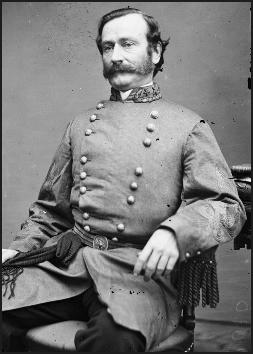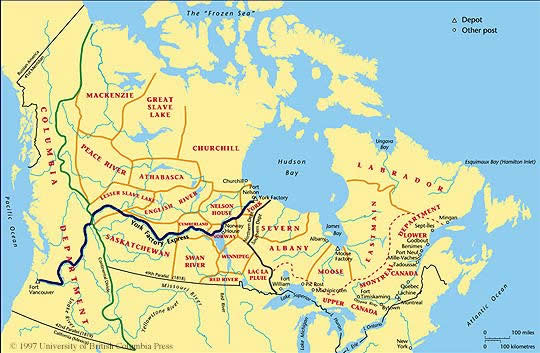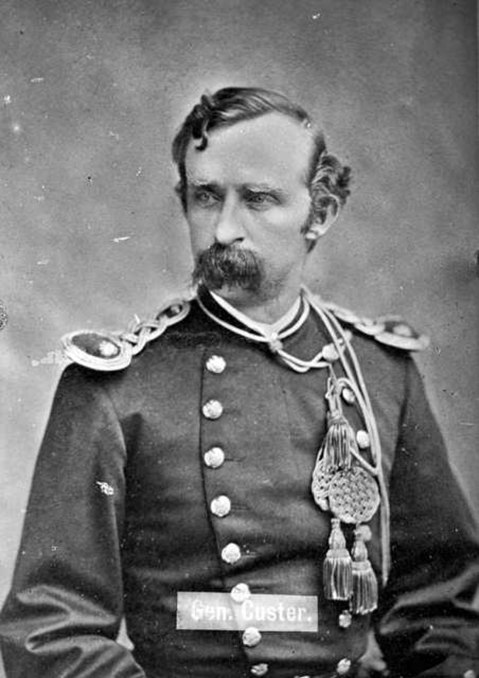Following the debacle of Washington City, Meade led his troops south in retreat. On March 15th, a French supply wagon turned them back into a fighting force. Also, news had come of the adoption of a new Royalist flag - a bison on a white field with a red-and-white checked border. This new flag of defiance to the Northern rebels was flown eagerly, as were the new white regimental banners. Morale lifted, Meade's army awaited new orders.
Royalist General Mansfield Lovell
On March 20th, those orders arrived. General Mansfield Lovell was about to make a thrust up the Mississippi, in an attempt to defeat Schicklgruber and take control over the river. Meade and his army boarded trains and rushed to join in the assault. On March 24th, they arrived. The first major offensive was near St. Louis, South Missouri. Royalist troops eager to avenge their defeats struck fiercely and savagely. After a landing point was secured, the main armies were brought in. Meade and Lovell then marched onward to St. Louis. It was after they saw the first road sign that they realized St. Louis had been renamed Louisborough to send a message to Catholics. Angrier than ever before, they practically sprinted the next 15 miles.
Upon hearing of the oncoming enemy offensive, Shicklgruber marched his army out of the city and went to meet the Royalists, hoping this would catch them off guard. Much to his angst, Meade's scouts, Jeb Stuart's dragoons, spotted him. Lovell's brand new artillery, straight from the New Orleans Foundry, set up in a small open patch, just off the side of the road. Schicklgruber's scouts, German lancers, the spotted the artillery and rushed back to alert him. Before long, both armies were dug in and entrenched. For three days, the two sides stared down their barrel sights at each other, only shooting in small little clusters and parties. Then, after receiving word Alexandrian reinforcements were coming in under Field Marshal Jefferson Davis, 2nd Baron Baton Rouge, a Protestant Southerner fighting to regain his barony. Davis was not extremely competent, and his army several times veered off from its destination because of lack of supplies and general poor planning. On March 24th, Lovell personally led 2,000 regulars over the trenches and straight at the center of Schicklgruber's line, after the Rebels had been softened up by an artillery salvo. After twenty minutes of brutal fighting, the attack was driven off. Lovell regrouped and consulted with Meade as to what should happen next. Meade ordered 2,500 infantry flanked by Jeb Stuart's cavalry to attack the left flank, through a densely wooded area.
Time was of the essence. Davis could arrive any time, and Schicklgruber had to be crushed by that point, or victory would almost surely be impossible. So, the thundering thousands advanced, light infantry firing 100 yards ahead to soften up the rebels. Finally, screaming bloody murder, the Royalists, mainly Akanseans, fell upon the enemy earthworks. Fierce resistance once again appeared ready to break the Southerners. But at last, the Bison flag was planted over the trench, and the Southern main army, which had been biting its nails waiting to see what would happen, cheered a cheer that shook the ground. The rebel left flank had been broken and its standards captured.
It must be understood, however, that this was by no means Schicklgruber's fault or a bad reflection upon his men. On the contrary, the remnants of one regiment, the 8th Wabash, which had sustained 70% casualties on the left flank and broke afterward, rushed to once again fight under "Fightin' Alois." Also on the contrary, all of this would have been prevented if Davis' forces had arrived on schedule.
After taking in the situation, Schicklgruber decided he would wheel his army around just far enough to fire on the Royalists who had destroyed his left flank. But when he did that, Meade launched a secret force of lancers at his now exposed right flank. This was actually what Schicklgruber wanted. Now, he brought up his long rifle-equipped Kaintuck volunteers to snipe the lancers enough to take the tip of the charge's spear. Soon, piles of horses and men dotted the ground up to the right flank, and the attack failed, leaving Meade and Lovell with only Stuart's cavalry, which was actually
on the left flank, about to come under rebel fire. Seeing no choice, the entire Royalist army climbed over their static fortifications and charged Alois' army itself, firing muskets as it advanced. Once they had fired, they went with their bayonets. Now, with Meade and Lovell hammering his right flank and right center and Stuart on his left flank, Schicklgruber was in a tight spot. If he chose to retreat now or in a few minutes, he could likely hook up with the tardy Davis and defend Louisborough, much like Hancock had defended Washington City. If he chose to fight it out, he might prevail. Or he might lose the battle, his army, and his command. Thus, he decided to resist for ten minutes. If the rebels were not close to retreating by then in substantial numbers, he would retreat and leave a vanguard to harass and slow the Royalists.
Royalist light infantry engage the 84th PA Zouaves in hand-to-hand combat
For ten minutes the fate of the battle and the capital of South Missouri hung in the balance. For ten minutes, the two groups of Americans killed each other in droves. The Mississippi turned red.
"Retreat!"
Who was it? Who had delivered the order? Southerner or Northerner? Had Davis arrived to stave off the Royalist horde? All this passed through the Alexandrian's heads in less than five seconds.
It was Schicklgruber. The Northern army was in retreat to Louisborough.
Davis was now within hearing distance of the battle. He had been only several minutes late. Sobbing over his failure, he fell into a state of deep self-hatred while joining Schicklgruber on the rout, saying "It is I! I am the reason for this loss!"
Alexandrian forces seek cover in the outskirts of Louisborough during the rout
The Royalist army was right on the Northerners' heels. Hundreds on both sides were going down in the vanguard battles. At last, the Northerners arrived in Louisborough. The city was promptly surrounded, and a surrender demanded. Meade was determined not to repeat Washington City. He
would win. It was a matter of honor. After taking assessments of the situation and after telegraphing Philadelphia, Schicklgruber received the order to surrender. With a grimace on his rotund, bearded face, eyes red from gunpowder, he presented the keys of the city to Meade under a flag of truce, and then was allowed to evacuate his forces. Louisborough had fallen to Andrew. South Missouri was for all essential reasons, a part of Andrew's realm now.






